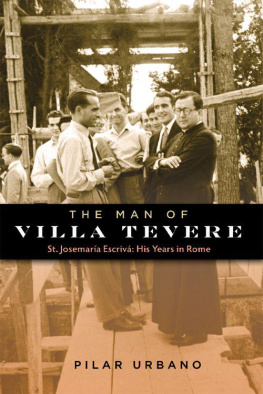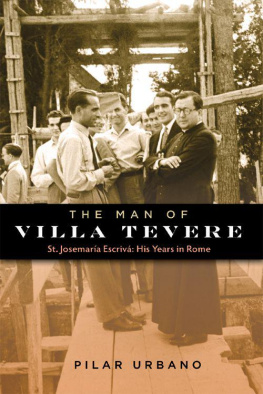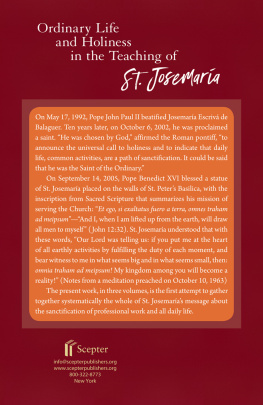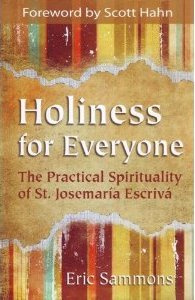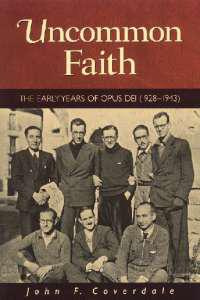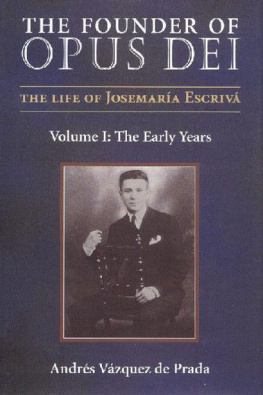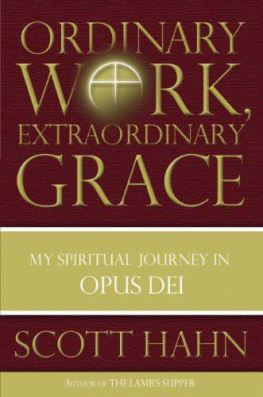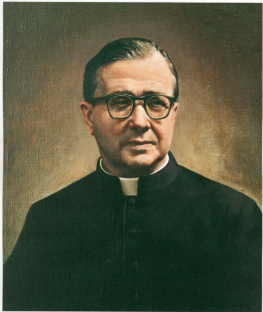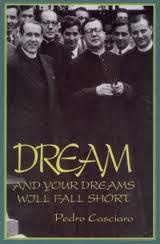
THE MAN OF
VILLA TEVERE
St. Josemara Escriv: His Years in Rome
THE MAN OF
VILLA TEVERE
St. Josemara Escriv: His Years in Rome
Pilar Urbano
Translated by Helena Scott

With ecclesiastical approval
The original work, Hombre de Villa Tevere, is Fundacion Studium, published by Editorial Plaza y Jans, Barcelona, 1995. Pilar Urbano, 1994.
TranslationScepter (U.K.) Ltd., 2002
Second editionScepter (U.K.) Ltd., 2003
This edition 2011, Scepter Publishers, Inc., New York.
Cover and inside photos courtesy of Fundacion Studium, Madrid.
All rights reserved. No part of this book may be reproduced, excerpted or transmitted in any form by any means, electronic, mechanical, photo copying, or sound recording, except with the publishers prior written permission. Inquiries regarding reprints or excerpts should be sent to info@scepterpublishers.org or the address below.
Scepter Publishers, Inc.
P.O. Box 211, New York, N.Y. 10018
www.scepterpublishers.org
Translated by Helena Scott
Text design by Carol Sawyer/Rose Design
Printed in the United States of America
eBook ISBN: 978 1 59417 142 0
Library of Congress Cataloging-in-Publication Data
Urbano, Pilar.
[Hombre de Villa Tevere. English]
The man of Villa Tevere: St. Josemara Escriv: his years in Rome / Pilar Urbano; translated by Helena Scott.
p. cm.
Includes index.
ISBN 978-1-59417-142-0 (alk. paper)
1. Escriv de Balaguer, Josemara, Saint, 19021975. 2. Opus Dei (Society) I. Title.
BX4705.E676U7213 2011
267'.182092--dc22
[B]
2011013567
CONTENTS


Like Nietzsche, you said you could only believe
in a God who could dance
Well, I assure you he can:
I have known a man who danced with God.

S
eptember 1966: the poplars at Molinoviejo conference center, near Segovia in central Spain, were turning gold. A painter named Luis Mosquera had set up an improvised studio in a seminar room. He came from Madrid every morning to paint a portrait outside his own studio as an absolute exception, as he put it, because this sitter really interests me.
The sitter had to overcome his dislike of posing with his hands folded. Ten sessions, he complained, as if I were a film star! Mosquera wanted even more time. I need two or three times that many sessions. Im a slow worker, because I think a lot about each brush stroke. In the end they agreed on five sessions, each two and a half hours.
Mosquera knew the clothing would be a problem in this portrait. Monsignor Escriv was wearing a plain black cassock, the only relief provided by his white clerical collar and the white cuffs at his wrists. The entire portraits vitality would have to come from the face and hands.
The painter could see he was faced with a subject of notable contrasts. He had to get onto canvas a mature person who projected the vitality of youth; an ascetic character, tempered by suffering but still joyful. This was a contemplative overflowing with activity; clearly a great intellectual, yet with none of an intellectuals aloofness; a very simple person who could be forthright when he had to but was not brusque. He was pleasantly serious; a peaceful man, but prepared to fight for what he believed in. One had only to look at him. His firm jaw indicated tenacity; his mouth, strength of character and self-control. The deep lines on his forehead showed a character molded by past sufferingsor maybe present ones.
As Mosquera studied his subject he became more and more interested in this personality. For some time he debated with himself how to get this complex priest onto canvas. In the end, as he dipped his brushes into sienna and ochre, he made up his mind: A priest first, but one who is deeply human.
Mosquera studied the hands: vigorous, strong, capable, expressive. He could imagine them taking up a pen thousands of times, telling the beads of many rosaries, handling the Christian mystery of the Eucharist day after day for years. They were the hands of a craftsman, hard working hands, made for work well done. Something like the hands of a potter.
Three characteristics stood out in the face. There was intelligence. There was friendlinessor was it an intense capacity to communicate? And there was a third factor, an indefinable element that was to be the painters main challenge in all five sittings. It was something very subtle, difficult to grasp, let alone recreate on canvas. Nevertheless there it was, not so much seen as glimpsed, from the moment the painter came face to face with his subject each morning at eleven, with the golden-leafed autumn poplars as background.
He was to discover it gradually, observing the priest in silence, scrutinizing his features, listening to him speak while posing, or feeling penetrated by his gaze.
He became very interested in that gaze. In contrast to so many others, those eyes seemed to bring light forth from the interior of the personlike genuine Russian icons which are drenched with the golden light they bear within. That gaze, rather than reflecting images of the world outside, seemed to communicate messages from its own inner depth. It was an attentive gaze that did not scrutinize; neither intrusive, inquisitive, nor questioning. A gaze which, paradoxically, saw , yet did not look ! Those eyes, small, short-sighted, and bright, had the rare trait of piercing through the present, as if observing faraway horizons, while at the same time establishing a close, affectionate rapport. Mosquera found himself confronted with an enigma: it was as if those eyes were holding back out of respect, while at the same time breaking down barriers by coming forward to meet the person before them. It was only later that he would discover that the secret was not so much in the eyes as in their look. How was he to translate that look onto canvas? It was the gaze of an adventurer, a patient voyager who, forging ever farther into the deep, watched the stars and scanned oceans. Where had he seen that gaze before? In which port, on what beach, in which fishing boat had he seen that deep, attentive, concentrated look of a fisherman gazing into the distance?
There were witnesses to these scenes: Alvaro del Portillo, Javier Echevarria, Florencio Sanchez Bella, Emilio Muoz Jofre, and Alejandro Cantero. One of them made the following notes during those September days.
So that he could get a fuller idea of his subject, Mosquera asked the Father to talk while he was posing. Yesterday several of us were in the studio with him. The Father was the life and soul of a pleasant, animated, amusing conversation. We were interested to see what was going on, and he spoke to all of us. But, as time passed, he focused more on Mosquera. The Father was a docile model according to the painter. At his suggestion the Father folded his arms and kept them folded, staying quite still, scarcely breathing. When Mosquera at last said Thatll do, he carried on talking normally but still didnt change his position. Today I was alone with the Father and the painter, sitting in a corner of the studio for a whole session. The Father was speaking to Mosquera in terms of close friendship. He called him by his first name, Luis. Rather than praising his talent, he applauded the effort and enthusiasm with which he tackled his work. From there he went on to explain how Luis could make his art into something holy, something both human and divine. Then in plain, simple language, he told him what Opus Dei is. And with moving sincerity he told Luis that God had chosen to use him, the Father, as an instrument to carry out the Work in the world. He stressed, with absolute conviction, that he himself was a clumsy, deaf instrument who saw himself as full of wretchedness, capable of every error and every horror, but who at the same time only desired to love Jesus Christ madly.
Next page
